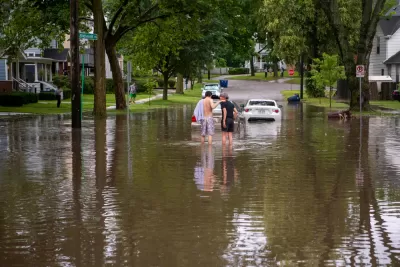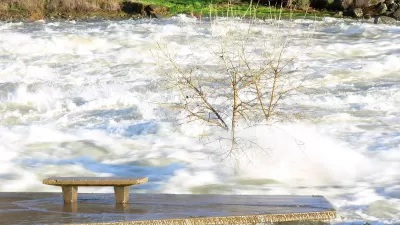The realities of climate change have been on full display in Michigan this summer, and a crusading drain commissioner is pushing for stormwater infrastructure that uses natural features to capture and reuse water during extreme weather.

With memories of massive flooding still fresh from storms this summer, Sarah Grimmer details efforts around the state to increase its stormwater mitigation.
Some in the state are noticing the challenge of stormwater for the first time because the climate in the state is changing. "Since 1986, total annual precipitation across most of Michigan's lower peninsula has increased by more than 10 percent," writes Grimmer.
Now the state and its local and regional planning authorities are facing the challenge of updating its infrastructure—built on old assumptions on how much rain would fall on the state—for the new reality of climate change.
Ingham County Drain Commissioner Patrick Lindemann is cited extensively in the article to describe both the need for new infrastructure, as well as the challenges, like a lack of funding, standing in the way of a more resilient state. Lindemann suggests that instead of simply installing larger drainpipes—a task which many Michigan governments can't afford—a preferable strategy might be to rethink how to handle stormwater altogether.
Instead of funneling excess water in the Great Lakes, Lindemann wants to restore watersheds and create wetlands and ponds. "These projects work to hold rainfall and use it rather than pushing it out," explains Grimmer.
"The drain commissioner's goal is to build around 50 of these projects in Ingham County, he says it will take about 40 to 50 years to get this work done and, in the process, rebuild the county's infrastructure so that it can handle our new environment."
FULL STORY: Massive rainfall events aren't going away in Michigan. Experts say our infrastructure needs to adapt

Study: Maui’s Plan to Convert Vacation Rentals to Long-Term Housing Could Cause Nearly $1 Billion Economic Loss
The plan would reduce visitor accommodation by 25,% resulting in 1,900 jobs lost.

North Texas Transit Leaders Tout Benefits of TOD for Growing Region
At a summit focused on transit-oriented development, policymakers discussed how North Texas’ expanded light rail system can serve as a tool for economic growth.

Why Should We Subsidize Public Transportation?
Many public transit agencies face financial stress due to rising costs, declining fare revenue, and declining subsidies. Transit advocates must provide a strong business case for increasing public transit funding.

How to Make US Trains Faster
Changes to boarding platforms and a switch to electric trains could improve U.S. passenger rail service without the added cost of high-speed rail.

Columbia’s Revitalized ‘Loop’ Is a Hub for Local Entrepreneurs
A focus on small businesses is helping a commercial corridor in Columbia, Missouri thrive.

Invasive Insect Threatens Minnesota’s Ash Forests
The Emerald Ash Borer is a rapidly spreading invasive pest threatening Minnesota’s ash trees, and homeowners are encouraged to plant diverse replacement species, avoid moving ash firewood, and monitor for signs of infestation.
Urban Design for Planners 1: Software Tools
This six-course series explores essential urban design concepts using open source software and equips planners with the tools they need to participate fully in the urban design process.
Planning for Universal Design
Learn the tools for implementing Universal Design in planning regulations.
Ascent Environmental
Borough of Carlisle
Institute for Housing and Urban Development Studies (IHS)
City of Grandview
Harvard GSD Executive Education
Toledo-Lucas County Plan Commissions
Salt Lake City
NYU Wagner Graduate School of Public Service





























